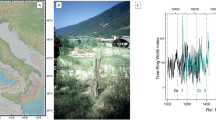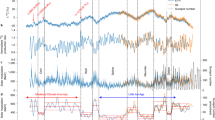Abstract
The Younger Dryas interval during the Last Glacial Termination was an abrupt return to glacial-like conditions punctuating the transition to a warmer, interglacial climate. Despite recent advances in the layer counting of ice-core records of the termination, the timing and length of the Younger Dryas remain controversial. Also, a steep rise in the concentration of atmospheric radiocarbon at the onset of the interval, recorded primarily in the Cariaco Basin, has been difficult to reconcile with simulations of the Younger Dryas carbon cycle. Here we discuss a radiocarbon chronology from a tree-ring record covering the Late Glacial period that has not been absolutely dated. We correlate the chronology to ice-core timescales using the common cosmic production signal in tree-ring 14C and ice-core 10Be concentrations. The results of this correlation suggest that the Cariaco record may be biased by changes in the concentration of radiocarbon in the upper ocean during the early phase of the Younger Dryas climate reversal in the Cariaco basin. This bias in the marine record may also affect the accuracy of a widely used radiocarbon calibration curve over this interval. Our tree-ring-based radiocarbon record is easily reconciled with simulated production rates and carbon-cycle changes associated with reduced ocean ventilation during the Younger Dryas.
This is a preview of subscription content, access via your institution
Access options
Subscribe to this journal
Receive 12 print issues and online access
$259.00 per year
only $21.58 per issue
Buy this article
- Purchase on Springer Link
- Instant access to full article PDF
Prices may be subject to local taxes which are calculated during checkout




Similar content being viewed by others
References
Dansgaard, W., White, J. W. C. & Johnsen, S. J. The abrupt termination of the younger dryas climate event. Nature 339, 532–534 (1989).
Björck, S. et al. An event stratigraphy for the last termination in the North Atlantic region based on the Greenland ice-core record: A proposal by the INTIMATE group. J. Quatern. Sci. 13, 283–292 (1998).
Litt, T. et al. Correlation and synchronisation of Lateglacial continental sequences in northern central Europe based on annually laminated lacustrine sediments. Quat. Sci. Rev. 20, 1233–1249 (2001).
Wang, Y. J. et al. A high-resolution absolute-dated late pleistocene monsoon record from Hulu Cave, China. Science 294, 2345–2348 (2001).
Hughen, K. A., Overpeck, J. T., Peterson, L. C. & Trumbore, S. Rapid climate changes in the tropical Atlantic region during the last deglaciation. Nature 380, 51–54 (1996).
Hendy, I. L., Kennett, J. P., Roark, E. B. & Ingram, B. L. Apparent synchroneity of submillennial scale climate events between Greenland and Santa Barbara Basin, California from 30–10 ka. Quat. Sci. Rev. 21, 1167–1184 (2002).
Friedrich, M. et al. High-resolution climate signals in the Bølling-Allerød Interstadial (Greenland Interstadial 1) as reflected in European tree-ring chronologies compared to marine varves and ice-core records. Quat. Sci. Rev. 20, 1223–1232 (2001).
Friedrich, M., Lücke, A., Schwalb, A. & Hanisch, S. Late glacial environmental and climatic changes from synchronized terrestrial archives of central Europe: The network PROSIMUL. PAGES Newslett. 12, 27–29 (2004).
Ammann, B. & Lotter, A. F. Late-Glacial radiocarbon- and palynostratigraphy on the Swiss Plateau. Boreas 18, 109–126 (1989).
Björck, S., Koç, N. & Skog, G. Consistently large marine reservoir ages in the Norwegian Sea during the Last Deglaciation. Quat. Sci. Rev. 22, 429–435 (2003).
Rasmussen, S. O. et al. A new Greenland ice core chronology for the last glacial termination. J. Geophys. Res. 111, D06102 (2006).
Meese, D. A. et al. The Greenland Ice Sheet Project 2 depth-age scale: Methods and results. J. Geophys. Res. 102, 26411–26424 (1997).
Hughen, K. A., Southon, J. R., Lehman, S. J. & Overpeck, J. T. Synchronous radiocarbon and climate shifts during the last deglaciation. Science 290, 1951–1954 (2000).
McManus, J. F., Francois, R., Gherardi, J.-M., Keigwin, L. D. & Brown-Leger, S. Collapse and rapid resumption of Atlantic meridional circulation linked to deglacial climate changes. Nature 428, 834–837 (2004).
Stuiver, M. & Polach, H. A. Discussion: Reporting of 14C data. Radiocarbon 19, 355–363 (1977).
Goslar, T. et al. High concentration of atmospheric 14C during the Younger Dryas cold episode. Nature 377, 414–417 (1995).
Björck, S. et al. Synchronized terrestrial–atmospheric deglacial records around the North Atlantic. Science 274, 1155–1160 (1996).
Stocker, T. F. & Wright, D. G. Rapid changes in ocean circulation and atmospheric radiocarbon. Paleoceanography 11, 773–795 (1996).
Hughen, K. et al. Deglacial changes in ocean circulation from an extended radiocarbon calibration. Nature 391, 65–68 (1998).
Goslar, T., Arnold, M., Tisnerat-Laborde, N., Czernik, J. & Wickowski, K. Variations of Younger Dryas atmospheric radiocarbon explicable without ocean circulation changes. Nature 403, 877–880 (2000).
Muscheler, R., Beer, J., Wagner, G. & Finkel, R. C. Changes in deep-water formation during the Younger Dryas cold period inferred from a comparison of 10Be and 14C records. Nature 408, 567–570 (2000).
Friedrich, M. et al. The 12,460-year Hohenheim oak and pine tree-ring chronology from central Europe—a unique annual record for radiocarbon calibration and paleoenvironment reconstructions. Radiocarbon 46, 1111–1122 (2004).
Reimer, P. J. et al. INTCAL04 terrestrial radiocarbon age calibration, 0-26 CAL KYR BP. Radiocarbon 46, 1029–1058 (2004).
Delaygue, G., Stocker, T. F., Joos, F. & Plattner, G.-K. Simulation of atmospheric radiocarbon during abrupt oceanic circulation changes: Trying to reconcile models and reconstructions. Quat. Sci. Rev. 22, 1647–1658 (2003).
Schaub, M., Kaiser, K. F., Kromer, B. & Talamo, S. Extension of the Swiss Lateglacial tree-ring chronologies. Dendrochronologia 23, 11–18 (2005).
Kromer, B. et al. Late glacial 14C ages from a floating, 1382-ring pine chronology. Radiocarbon 46, 1203–1209 (2004).
Lal, D. & Peters, B. in Handbuch für Physik (ed. Flügge, S.) 551–612 (Springer, Berlin, 1967).
Andersen, K. K. et al. The Greenland ice core chronology 2005, 15–42 ka. Part 1: Constructing the time scale. Quat. Sci. Rev. 25, 3246–3257 (2006).
Svensson, A. et al. The Greenland ice core chronology 2005, 15-42 ka. Part 2: Comparison to other records. Quat. Sci. Rev. 25, 3258–3267 (2006).
Yiou, F. et al. Beryllium 10 in the Greenland Ice Core Project ice core at Summit, Greenland. J. Geophys. Res. 102, 26783–26794 (1997).
Wagner, G. et al. Chlorine-36 evidence for the Mono Lake event in the Summit GRIP ice core. Earth Planet. Sci. Lett. 181, 1–6 (2000).
Wagner, G. et al. Presence of the solar de Vries cycle (205 years) during the last ice age. Geophys. Res. Lett. 28, 303–306 (2001).
Muscheler, R., Beer, J., Kubik, P. W. & Synal, H.-A. Geomagnetic field intensity during the last 60,000 years based on 10Be & 36Cl from the Summit ice cores and 14C. Quat. Sci. Rev. 24 (2005) (doi:10.1016/j.quascirev.2005.01.012).
Vonmoos, M., Beer, J. & Muscheler, R. Large variations in Holocene solar activity: Constraints from 10Be in the Greenland Ice Core Project ice core. J. Geophys. Res. 111doi:10.1029/2005JA011500 (2006).
Finkel, R. C. & Nishiizumi, K. Beryllium 10 concentrations in the Greenland ice sheet project 2 ice core from 3–40 ka. J. Geophys. Res. 102, 26699–26706 (1997).
Johnsen, S. J. et al. The δ18O record along the Greenland Ice Core Project deep ice core and the problem of possible Eemian climatic instability. J. Geophys. Res. 102, 26397–26410 (1997).
Alley, R. B. et al. Changes in continental and sea-salt atmospheric loadings in central Greenland during the most recent deglaciation: Model-based estimates. J. Glaciol. 41, 503–514 (1995).
Fairbanks, R. G. et al. Radiocarbon calibration curve spanning 0 to 50,000 years BP based on paired 230Th/234U/238U and 14C dates on pristine corals. Quat. Sci. Rev. 24, 1781–1796 (2005).
Cao, L., Fairbanks, R. G., Mortlock, R. A. & Risk, M. J. Radiocarbon reservoir age of high latitude North Atlantic surface water during the last deglacial. Quat. Sci. Rev. 26, 732–742 (2007).
Muscheler, R. et al. Changes in the carbon cycle during the last deglaciation as indicated by the comparison of 10Be and 14C records. Earth Planet. Sci. Lett. 219, 325–340 (2004).
Brauer, A., Endres, C. & Negendank, J. F. W. Lateglacial calendar year chronology based on annually laminated sediments from Lake Meerfelder Maar, Germany. Quat. Int. 61, 17–25 (1999).
Kaiser, K. F. Beiträge zur Klimageschichte vom Hochglazial bis ins frühe Holozän, rekonstruiert mit Jahrringen und Molluskenschalen aus verschiedenen Vereisungsgebieten (Ziegler Druck & Verlags-AG, Winterthur und WSL/FNP, Birmensdorf, 1993).
Friedrich, M., Kromer, B., Spurk, M., Hofmann, J. & Kaiser, K. F. Paleo-environment and radiocarbon calibration as derived from Lateglacial/Early Holocene tree-ring chronologies. Quat. Int. 61, 27–39 (1999).
Mortensen, A. K., Bigler, M., Grönvold, K., Steffensen, J. P. & Johnsen, S. J. Volcanic ash layers from the Last Glacial Termination in the NGRIP ice core. J. Quat. Sci. 20, 209–219 (2005).
Stuiver, M. & Grootes, P. M. GISP2 oxygen isotope ratios. Quat. Res. 53, 277–284 (2000).
Siegenthaler, U. Uptake of excess CO2 by an outcrop-diffusion model ocean. J. Geophys. Res. 88, 3599–3608 (1983).
Beck, J. W. et al. Extremely large variations of atmospheric 14C concentration during the last glacial period. Science 292, 2453–2458 (2001).
Bard, E., Arnold, M., Hamelin, B., Tisnerat-Laborde, N. & Cabioch, G. Radiocarbon calibration by means of mass spectrometric 230Th/234U and 14C ages of corals. An update data base including samples from Barbados, Mururoa and Tahiti. Radiocarbon 40, 1085–1092 (1998).
Kitagawa, H. & van der Plicht, J. Atmospheric radiocarbon calibration beyond 11,900 Cal BP from Lake Suigetsu laminated sediments. Radiocarbon 42, 369–380 (2000).
Acknowledgements
We thank M. Schaub for his contribution to the building of the Swiss Late Glacial tree-ring chronology supported by the Department of Construction of Canton Zurich, Switzerland. This work was supported by the Swedish Research Council. B.K. and M.F. were funded by the ESF (European Science Foundation), EuroCores project ‘EuroClimate’ (Kr 726/3). Initial tree-ring work of M.F. was funded by the German Ministry of Education and Research (DEKLIM—PROSIMUL1/01LD0002).
Author information
Authors and Affiliations
Contributions
R.M. proposed the 10Be–14C link, initiated the paper and did the calculations. Each co-author contributed especially to his own field of expertise. B.K., M.F. and K.F.K. were the main contributors for the development of the floating tree-ring 14C record. A.S. provided details on the ice-core dating and accumulation rate. S.B. and J.S. provided background and input on the climate, dating and correlation discussion. J.S. suggested a similar placement of the floating tree-ring chronology at the Second Carlsberg Dating Conference in Copenhagen. R.M. wrote the paper, with comments and input provided by all other authors.
Corresponding author
Rights and permissions
About this article
Cite this article
Muscheler, R., Kromer, B., Björck, S. et al. Tree rings and ice cores reveal 14C calibration uncertainties during the Younger Dryas. Nature Geosci 1, 263–267 (2008). https://doi.org/10.1038/ngeo128
Received:
Accepted:
Published:
Issue Date:
DOI: https://doi.org/10.1038/ngeo128
This article is cited by
-
Punctuated Shutdown of Atlantic Meridional Overturning Circulation during Greenland Stadial 1
Scientific Reports (2016)
-
Postglacial Fringing-Reef to Barrier-Reef conversion on Tahiti links Darwin's reef types
Scientific Reports (2014)
-
Persistent link between solar activity and Greenland climate during the Last Glacial Maximum
Nature Geoscience (2014)
-
Quantification of 60Fe atoms by MC-ICP-MS for the redetermination of the half-life
Analytical and Bioanalytical Chemistry (2013)
-
Enhanced sea-ice export from the Arctic during the Younger Dryas
Nature Communications (2012)



